Annotated Bibliography: Exploring the Elderly and Tourism Trends
VerifiedAdded on 2022/12/14
|10
|2328
|74
Report
AI Summary
This report presents an annotated bibliography focusing on the elderly and tourism. It begins with an abstract summarizing the key themes, followed by a table of contents. The core of the report consists of five annotated bibliographies, each summarizing a research article related to elderly tourism. The articles cover topics such as the growing market of senior tourism, the importance of understanding senior travel behavior, the impact of tourism experiences on health, the effects of critical incidents on travel behavior, and the role of service expectations in wellness tourism among seniors. Each annotation includes a summary of the article's objectives, methodology, findings, and limitations. The report concludes by emphasizing the importance of understanding the needs of the elderly population to customize tourism products and services, and to capitalize on the opportunities presented by this growing market segment. The references section provides a list of all cited sources.
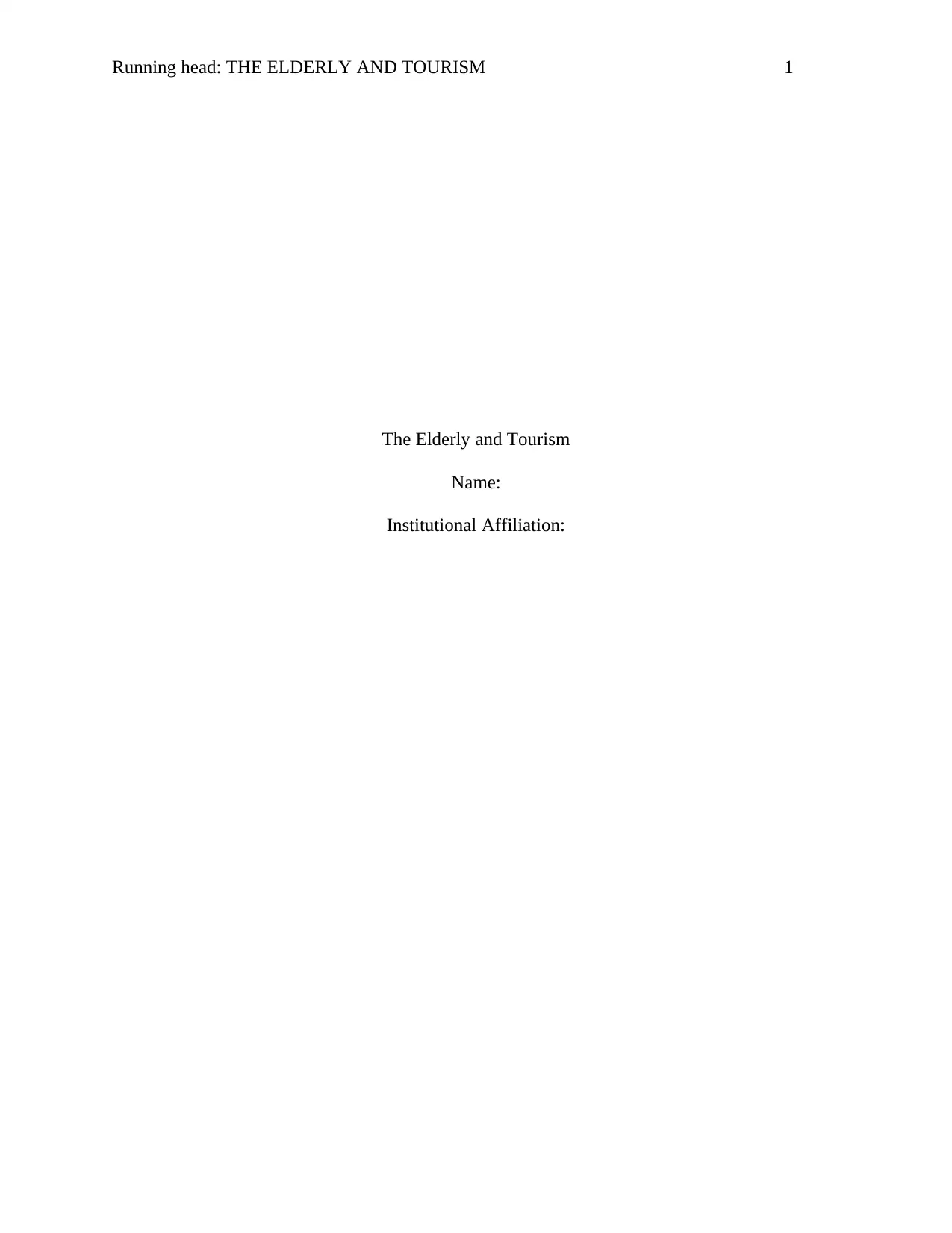
Running head: THE ELDERLY AND TOURISM 1
The Elderly and Tourism
Name:
Institutional Affiliation:
The Elderly and Tourism
Name:
Institutional Affiliation:
Paraphrase This Document
Need a fresh take? Get an instant paraphrase of this document with our AI Paraphraser
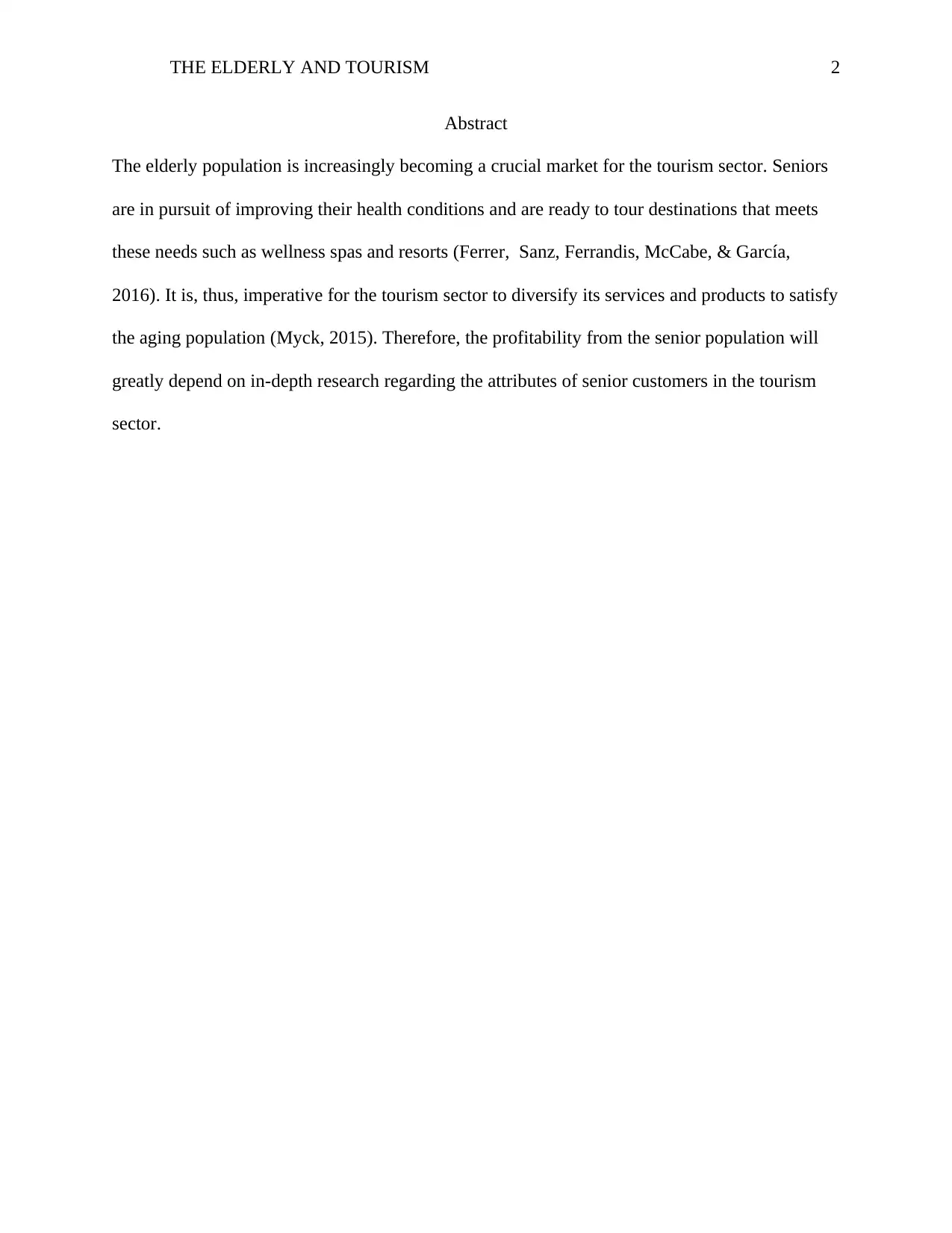
THE ELDERLY AND TOURISM 2
Abstract
The elderly population is increasingly becoming a crucial market for the tourism sector. Seniors
are in pursuit of improving their health conditions and are ready to tour destinations that meets
these needs such as wellness spas and resorts (Ferrer, Sanz, Ferrandis, McCabe, & García,
2016). It is, thus, imperative for the tourism sector to diversify its services and products to satisfy
the aging population (Myck, 2015). Therefore, the profitability from the senior population will
greatly depend on in-depth research regarding the attributes of senior customers in the tourism
sector.
Abstract
The elderly population is increasingly becoming a crucial market for the tourism sector. Seniors
are in pursuit of improving their health conditions and are ready to tour destinations that meets
these needs such as wellness spas and resorts (Ferrer, Sanz, Ferrandis, McCabe, & García,
2016). It is, thus, imperative for the tourism sector to diversify its services and products to satisfy
the aging population (Myck, 2015). Therefore, the profitability from the senior population will
greatly depend on in-depth research regarding the attributes of senior customers in the tourism
sector.
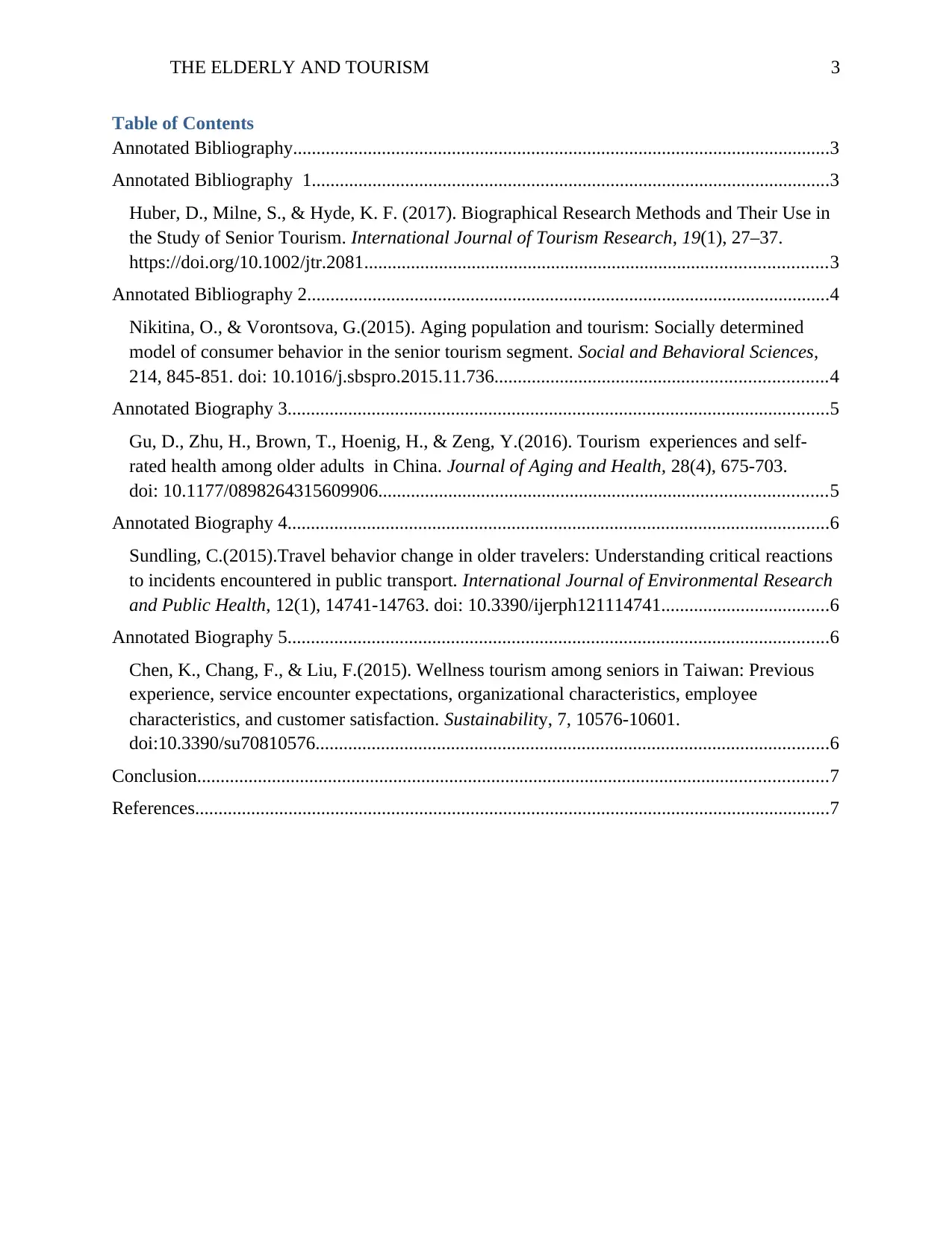
THE ELDERLY AND TOURISM 3
Table of Contents
Annotated Bibliography...................................................................................................................3
Annotated Bibliography 1...............................................................................................................3
Huber, D., Milne, S., & Hyde, K. F. (2017). Biographical Research Methods and Their Use in
the Study of Senior Tourism. International Journal of Tourism Research, 19(1), 27–37.
https://doi.org/10.1002/jtr.2081...................................................................................................3
Annotated Bibliography 2................................................................................................................4
Nikitina, O., & Vorontsova, G.(2015). Aging population and tourism: Socially determined
model of consumer behavior in the senior tourism segment. Social and Behavioral Sciences,
214, 845-851. doi: 10.1016/j.sbspro.2015.11.736.......................................................................4
Annotated Biography 3....................................................................................................................5
Gu, D., Zhu, H., Brown, T., Hoenig, H., & Zeng, Y.(2016). Tourism experiences and self-
rated health among older adults in China. Journal of Aging and Health, 28(4), 675-703.
doi: 10.1177/0898264315609906................................................................................................5
Annotated Biography 4....................................................................................................................6
Sundling, C.(2015).Travel behavior change in older travelers: Understanding critical reactions
to incidents encountered in public transport. International Journal of Environmental Research
and Public Health, 12(1), 14741-14763. doi: 10.3390/ijerph121114741....................................6
Annotated Biography 5....................................................................................................................6
Chen, K., Chang, F., & Liu, F.(2015). Wellness tourism among seniors in Taiwan: Previous
experience, service encounter expectations, organizational characteristics, employee
characteristics, and customer satisfaction. Sustainability, 7, 10576-10601.
doi:10.3390/su70810576..............................................................................................................6
Conclusion.......................................................................................................................................7
References........................................................................................................................................7
Table of Contents
Annotated Bibliography...................................................................................................................3
Annotated Bibliography 1...............................................................................................................3
Huber, D., Milne, S., & Hyde, K. F. (2017). Biographical Research Methods and Their Use in
the Study of Senior Tourism. International Journal of Tourism Research, 19(1), 27–37.
https://doi.org/10.1002/jtr.2081...................................................................................................3
Annotated Bibliography 2................................................................................................................4
Nikitina, O., & Vorontsova, G.(2015). Aging population and tourism: Socially determined
model of consumer behavior in the senior tourism segment. Social and Behavioral Sciences,
214, 845-851. doi: 10.1016/j.sbspro.2015.11.736.......................................................................4
Annotated Biography 3....................................................................................................................5
Gu, D., Zhu, H., Brown, T., Hoenig, H., & Zeng, Y.(2016). Tourism experiences and self-
rated health among older adults in China. Journal of Aging and Health, 28(4), 675-703.
doi: 10.1177/0898264315609906................................................................................................5
Annotated Biography 4....................................................................................................................6
Sundling, C.(2015).Travel behavior change in older travelers: Understanding critical reactions
to incidents encountered in public transport. International Journal of Environmental Research
and Public Health, 12(1), 14741-14763. doi: 10.3390/ijerph121114741....................................6
Annotated Biography 5....................................................................................................................6
Chen, K., Chang, F., & Liu, F.(2015). Wellness tourism among seniors in Taiwan: Previous
experience, service encounter expectations, organizational characteristics, employee
characteristics, and customer satisfaction. Sustainability, 7, 10576-10601.
doi:10.3390/su70810576..............................................................................................................6
Conclusion.......................................................................................................................................7
References........................................................................................................................................7
⊘ This is a preview!⊘
Do you want full access?
Subscribe today to unlock all pages.

Trusted by 1+ million students worldwide
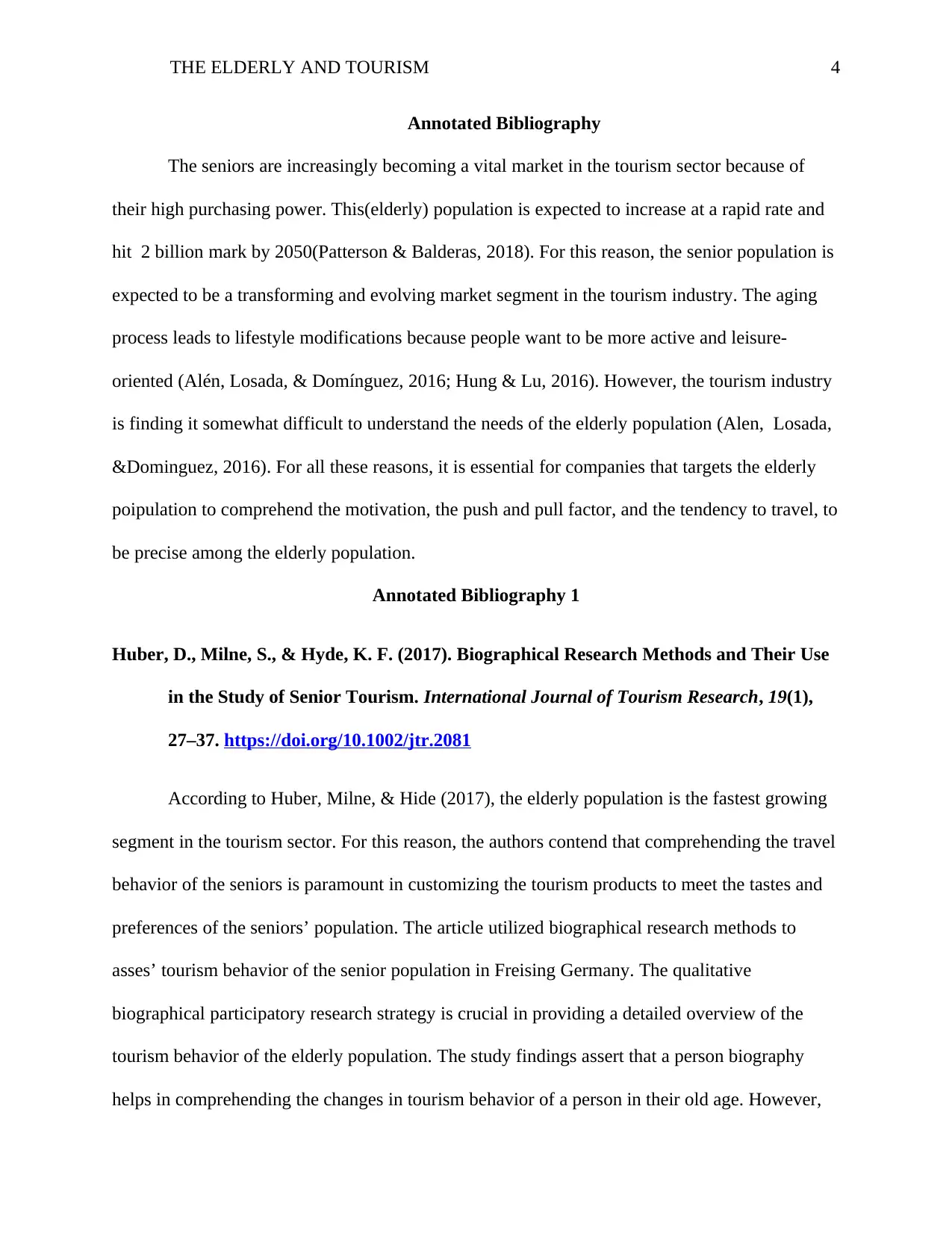
THE ELDERLY AND TOURISM 4
Annotated Bibliography
The seniors are increasingly becoming a vital market in the tourism sector because of
their high purchasing power. This(elderly) population is expected to increase at a rapid rate and
hit 2 billion mark by 2050(Patterson & Balderas, 2018). For this reason, the senior population is
expected to be a transforming and evolving market segment in the tourism industry. The aging
process leads to lifestyle modifications because people want to be more active and leisure-
oriented (Alén, Losada, & Domínguez, 2016; Hung & Lu, 2016). However, the tourism industry
is finding it somewhat difficult to understand the needs of the elderly population (Alen, Losada,
&Dominguez, 2016). For all these reasons, it is essential for companies that targets the elderly
poipulation to comprehend the motivation, the push and pull factor, and the tendency to travel, to
be precise among the elderly population.
Annotated Bibliography 1
Huber, D., Milne, S., & Hyde, K. F. (2017). Biographical Research Methods and Their Use
in the Study of Senior Tourism. International Journal of Tourism Research, 19(1),
27–37. https://doi.org/10.1002/jtr.2081
According to Huber, Milne, & Hide (2017), the elderly population is the fastest growing
segment in the tourism sector. For this reason, the authors contend that comprehending the travel
behavior of the seniors is paramount in customizing the tourism products to meet the tastes and
preferences of the seniors’ population. The article utilized biographical research methods to
asses’ tourism behavior of the senior population in Freising Germany. The qualitative
biographical participatory research strategy is crucial in providing a detailed overview of the
tourism behavior of the elderly population. The study findings assert that a person biography
helps in comprehending the changes in tourism behavior of a person in their old age. However,
Annotated Bibliography
The seniors are increasingly becoming a vital market in the tourism sector because of
their high purchasing power. This(elderly) population is expected to increase at a rapid rate and
hit 2 billion mark by 2050(Patterson & Balderas, 2018). For this reason, the senior population is
expected to be a transforming and evolving market segment in the tourism industry. The aging
process leads to lifestyle modifications because people want to be more active and leisure-
oriented (Alén, Losada, & Domínguez, 2016; Hung & Lu, 2016). However, the tourism industry
is finding it somewhat difficult to understand the needs of the elderly population (Alen, Losada,
&Dominguez, 2016). For all these reasons, it is essential for companies that targets the elderly
poipulation to comprehend the motivation, the push and pull factor, and the tendency to travel, to
be precise among the elderly population.
Annotated Bibliography 1
Huber, D., Milne, S., & Hyde, K. F. (2017). Biographical Research Methods and Their Use
in the Study of Senior Tourism. International Journal of Tourism Research, 19(1),
27–37. https://doi.org/10.1002/jtr.2081
According to Huber, Milne, & Hide (2017), the elderly population is the fastest growing
segment in the tourism sector. For this reason, the authors contend that comprehending the travel
behavior of the seniors is paramount in customizing the tourism products to meet the tastes and
preferences of the seniors’ population. The article utilized biographical research methods to
asses’ tourism behavior of the senior population in Freising Germany. The qualitative
biographical participatory research strategy is crucial in providing a detailed overview of the
tourism behavior of the elderly population. The study findings assert that a person biography
helps in comprehending the changes in tourism behavior of a person in their old age. However,
Paraphrase This Document
Need a fresh take? Get an instant paraphrase of this document with our AI Paraphraser
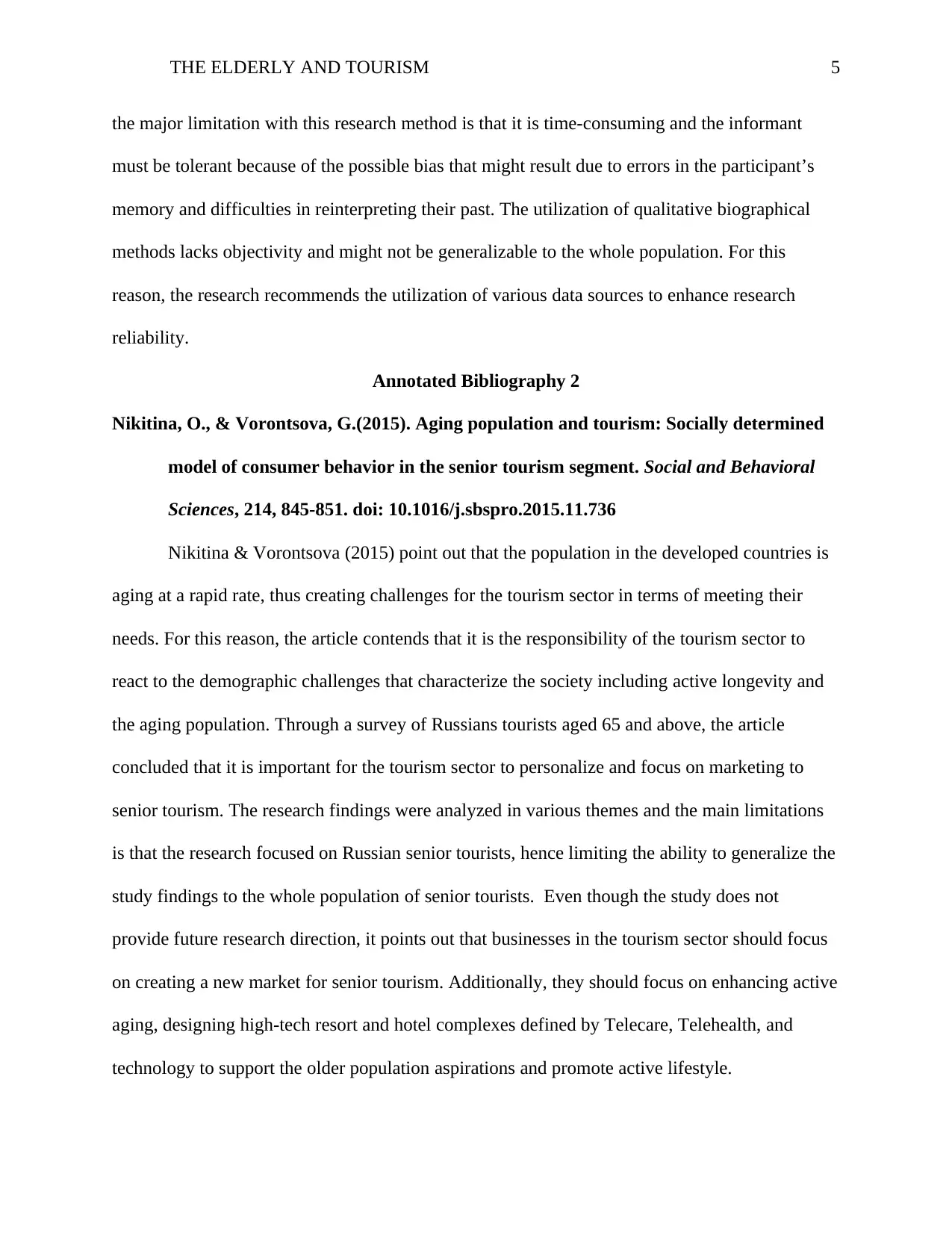
THE ELDERLY AND TOURISM 5
the major limitation with this research method is that it is time-consuming and the informant
must be tolerant because of the possible bias that might result due to errors in the participant’s
memory and difficulties in reinterpreting their past. The utilization of qualitative biographical
methods lacks objectivity and might not be generalizable to the whole population. For this
reason, the research recommends the utilization of various data sources to enhance research
reliability.
Annotated Bibliography 2
Nikitina, O., & Vorontsova, G.(2015). Aging population and tourism: Socially determined
model of consumer behavior in the senior tourism segment. Social and Behavioral
Sciences, 214, 845-851. doi: 10.1016/j.sbspro.2015.11.736
Nikitina & Vorontsova (2015) point out that the population in the developed countries is
aging at a rapid rate, thus creating challenges for the tourism sector in terms of meeting their
needs. For this reason, the article contends that it is the responsibility of the tourism sector to
react to the demographic challenges that characterize the society including active longevity and
the aging population. Through a survey of Russians tourists aged 65 and above, the article
concluded that it is important for the tourism sector to personalize and focus on marketing to
senior tourism. The research findings were analyzed in various themes and the main limitations
is that the research focused on Russian senior tourists, hence limiting the ability to generalize the
study findings to the whole population of senior tourists. Even though the study does not
provide future research direction, it points out that businesses in the tourism sector should focus
on creating a new market for senior tourism. Additionally, they should focus on enhancing active
aging, designing high-tech resort and hotel complexes defined by Telecare, Telehealth, and
technology to support the older population aspirations and promote active lifestyle.
the major limitation with this research method is that it is time-consuming and the informant
must be tolerant because of the possible bias that might result due to errors in the participant’s
memory and difficulties in reinterpreting their past. The utilization of qualitative biographical
methods lacks objectivity and might not be generalizable to the whole population. For this
reason, the research recommends the utilization of various data sources to enhance research
reliability.
Annotated Bibliography 2
Nikitina, O., & Vorontsova, G.(2015). Aging population and tourism: Socially determined
model of consumer behavior in the senior tourism segment. Social and Behavioral
Sciences, 214, 845-851. doi: 10.1016/j.sbspro.2015.11.736
Nikitina & Vorontsova (2015) point out that the population in the developed countries is
aging at a rapid rate, thus creating challenges for the tourism sector in terms of meeting their
needs. For this reason, the article contends that it is the responsibility of the tourism sector to
react to the demographic challenges that characterize the society including active longevity and
the aging population. Through a survey of Russians tourists aged 65 and above, the article
concluded that it is important for the tourism sector to personalize and focus on marketing to
senior tourism. The research findings were analyzed in various themes and the main limitations
is that the research focused on Russian senior tourists, hence limiting the ability to generalize the
study findings to the whole population of senior tourists. Even though the study does not
provide future research direction, it points out that businesses in the tourism sector should focus
on creating a new market for senior tourism. Additionally, they should focus on enhancing active
aging, designing high-tech resort and hotel complexes defined by Telecare, Telehealth, and
technology to support the older population aspirations and promote active lifestyle.
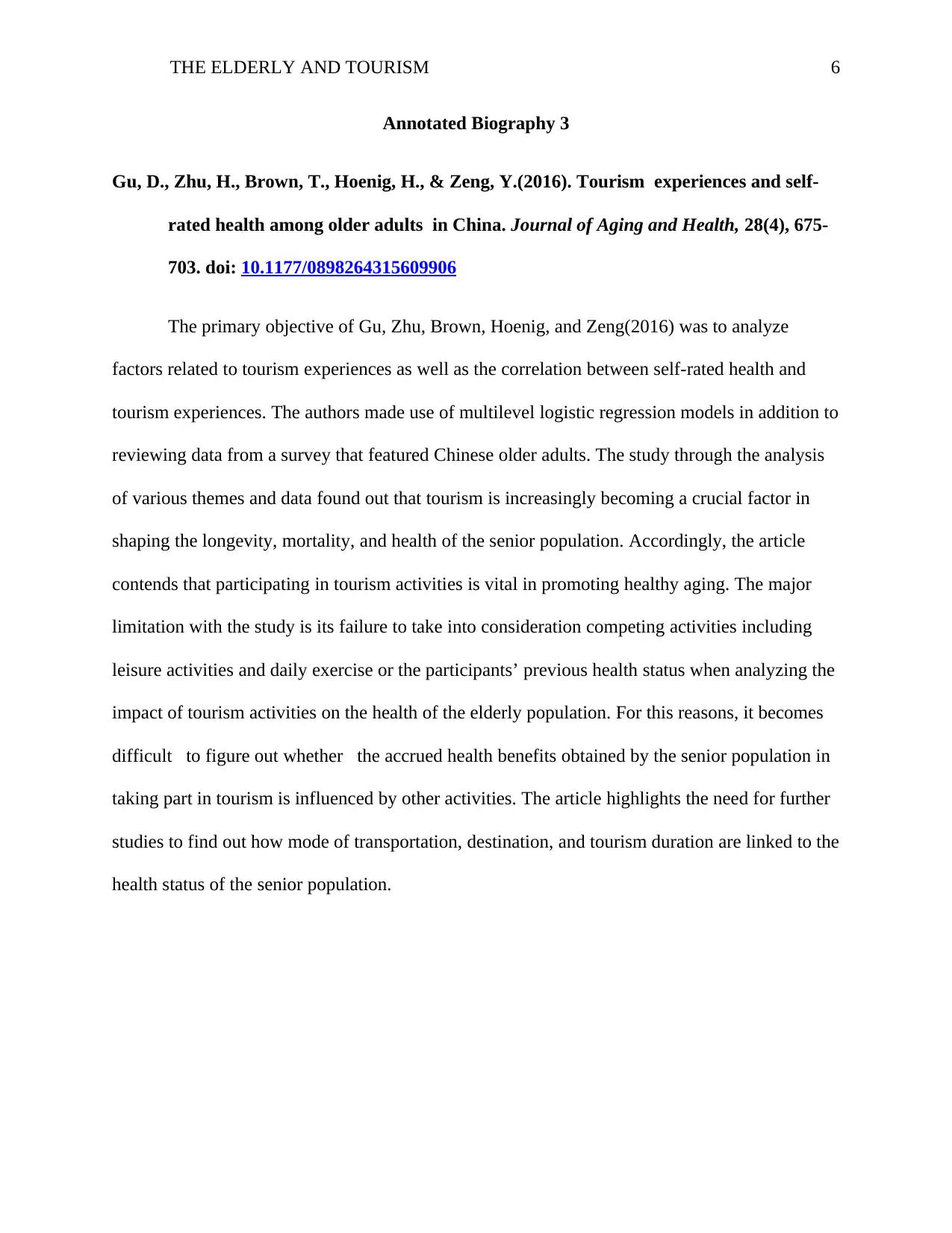
THE ELDERLY AND TOURISM 6
Annotated Biography 3
Gu, D., Zhu, H., Brown, T., Hoenig, H., & Zeng, Y.(2016). Tourism experiences and self-
rated health among older adults in China. Journal of Aging and Health, 28(4), 675-
703. doi: 10.1177/0898264315609906
The primary objective of Gu, Zhu, Brown, Hoenig, and Zeng(2016) was to analyze
factors related to tourism experiences as well as the correlation between self-rated health and
tourism experiences. The authors made use of multilevel logistic regression models in addition to
reviewing data from a survey that featured Chinese older adults. The study through the analysis
of various themes and data found out that tourism is increasingly becoming a crucial factor in
shaping the longevity, mortality, and health of the senior population. Accordingly, the article
contends that participating in tourism activities is vital in promoting healthy aging. The major
limitation with the study is its failure to take into consideration competing activities including
leisure activities and daily exercise or the participants’ previous health status when analyzing the
impact of tourism activities on the health of the elderly population. For this reasons, it becomes
difficult to figure out whether the accrued health benefits obtained by the senior population in
taking part in tourism is influenced by other activities. The article highlights the need for further
studies to find out how mode of transportation, destination, and tourism duration are linked to the
health status of the senior population.
Annotated Biography 3
Gu, D., Zhu, H., Brown, T., Hoenig, H., & Zeng, Y.(2016). Tourism experiences and self-
rated health among older adults in China. Journal of Aging and Health, 28(4), 675-
703. doi: 10.1177/0898264315609906
The primary objective of Gu, Zhu, Brown, Hoenig, and Zeng(2016) was to analyze
factors related to tourism experiences as well as the correlation between self-rated health and
tourism experiences. The authors made use of multilevel logistic regression models in addition to
reviewing data from a survey that featured Chinese older adults. The study through the analysis
of various themes and data found out that tourism is increasingly becoming a crucial factor in
shaping the longevity, mortality, and health of the senior population. Accordingly, the article
contends that participating in tourism activities is vital in promoting healthy aging. The major
limitation with the study is its failure to take into consideration competing activities including
leisure activities and daily exercise or the participants’ previous health status when analyzing the
impact of tourism activities on the health of the elderly population. For this reasons, it becomes
difficult to figure out whether the accrued health benefits obtained by the senior population in
taking part in tourism is influenced by other activities. The article highlights the need for further
studies to find out how mode of transportation, destination, and tourism duration are linked to the
health status of the senior population.
⊘ This is a preview!⊘
Do you want full access?
Subscribe today to unlock all pages.

Trusted by 1+ million students worldwide
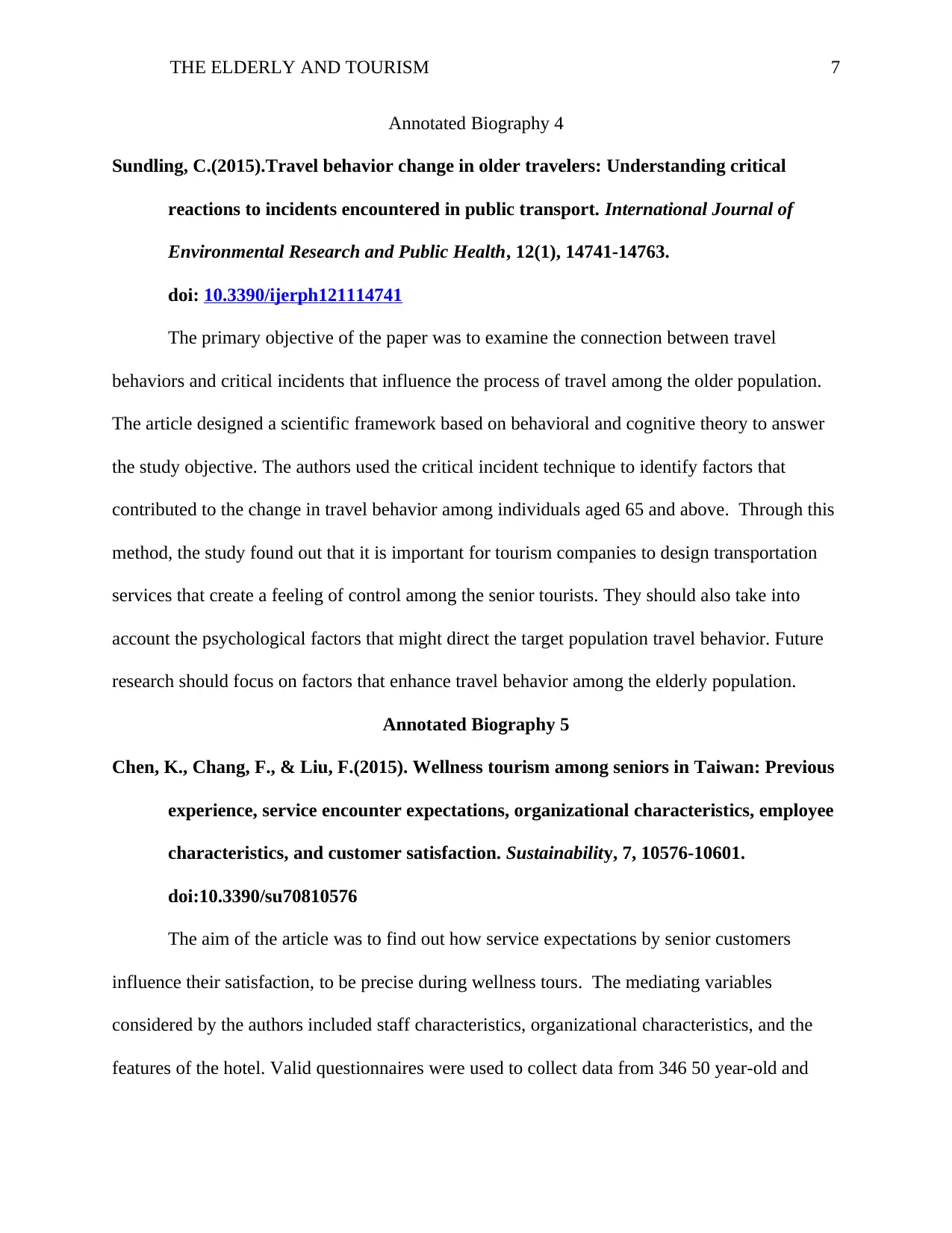
THE ELDERLY AND TOURISM 7
Annotated Biography 4
Sundling, C.(2015).Travel behavior change in older travelers: Understanding critical
reactions to incidents encountered in public transport. International Journal of
Environmental Research and Public Health, 12(1), 14741-14763.
doi: 10.3390/ijerph121114741
The primary objective of the paper was to examine the connection between travel
behaviors and critical incidents that influence the process of travel among the older population.
The article designed a scientific framework based on behavioral and cognitive theory to answer
the study objective. The authors used the critical incident technique to identify factors that
contributed to the change in travel behavior among individuals aged 65 and above. Through this
method, the study found out that it is important for tourism companies to design transportation
services that create a feeling of control among the senior tourists. They should also take into
account the psychological factors that might direct the target population travel behavior. Future
research should focus on factors that enhance travel behavior among the elderly population.
Annotated Biography 5
Chen, K., Chang, F., & Liu, F.(2015). Wellness tourism among seniors in Taiwan: Previous
experience, service encounter expectations, organizational characteristics, employee
characteristics, and customer satisfaction. Sustainability, 7, 10576-10601.
doi:10.3390/su70810576
The aim of the article was to find out how service expectations by senior customers
influence their satisfaction, to be precise during wellness tours. The mediating variables
considered by the authors included staff characteristics, organizational characteristics, and the
features of the hotel. Valid questionnaires were used to collect data from 346 50 year-old and
Annotated Biography 4
Sundling, C.(2015).Travel behavior change in older travelers: Understanding critical
reactions to incidents encountered in public transport. International Journal of
Environmental Research and Public Health, 12(1), 14741-14763.
doi: 10.3390/ijerph121114741
The primary objective of the paper was to examine the connection between travel
behaviors and critical incidents that influence the process of travel among the older population.
The article designed a scientific framework based on behavioral and cognitive theory to answer
the study objective. The authors used the critical incident technique to identify factors that
contributed to the change in travel behavior among individuals aged 65 and above. Through this
method, the study found out that it is important for tourism companies to design transportation
services that create a feeling of control among the senior tourists. They should also take into
account the psychological factors that might direct the target population travel behavior. Future
research should focus on factors that enhance travel behavior among the elderly population.
Annotated Biography 5
Chen, K., Chang, F., & Liu, F.(2015). Wellness tourism among seniors in Taiwan: Previous
experience, service encounter expectations, organizational characteristics, employee
characteristics, and customer satisfaction. Sustainability, 7, 10576-10601.
doi:10.3390/su70810576
The aim of the article was to find out how service expectations by senior customers
influence their satisfaction, to be precise during wellness tours. The mediating variables
considered by the authors included staff characteristics, organizational characteristics, and the
features of the hotel. Valid questionnaires were used to collect data from 346 50 year-old and
Paraphrase This Document
Need a fresh take? Get an instant paraphrase of this document with our AI Paraphraser
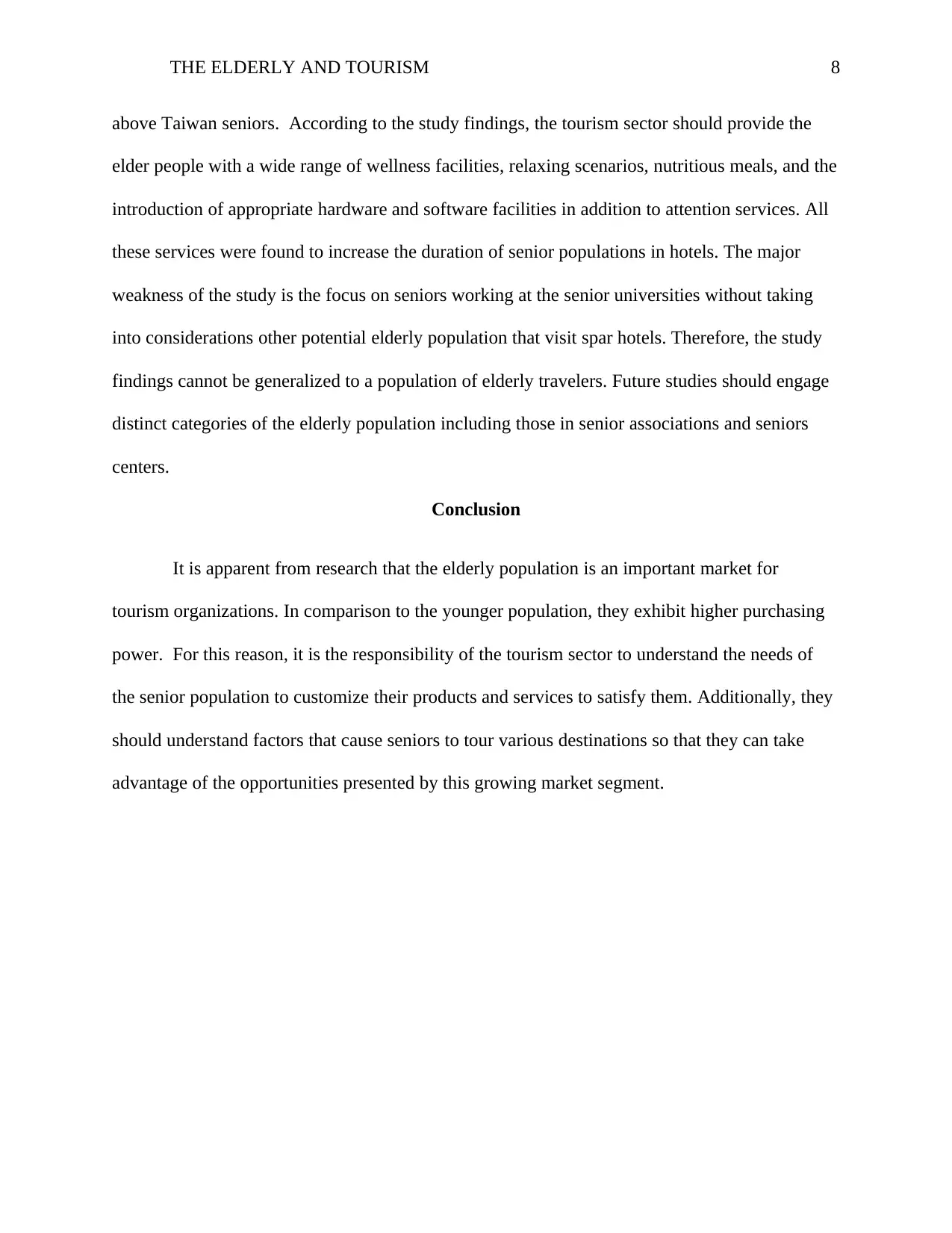
THE ELDERLY AND TOURISM 8
above Taiwan seniors. According to the study findings, the tourism sector should provide the
elder people with a wide range of wellness facilities, relaxing scenarios, nutritious meals, and the
introduction of appropriate hardware and software facilities in addition to attention services. All
these services were found to increase the duration of senior populations in hotels. The major
weakness of the study is the focus on seniors working at the senior universities without taking
into considerations other potential elderly population that visit spar hotels. Therefore, the study
findings cannot be generalized to a population of elderly travelers. Future studies should engage
distinct categories of the elderly population including those in senior associations and seniors
centers.
Conclusion
It is apparent from research that the elderly population is an important market for
tourism organizations. In comparison to the younger population, they exhibit higher purchasing
power. For this reason, it is the responsibility of the tourism sector to understand the needs of
the senior population to customize their products and services to satisfy them. Additionally, they
should understand factors that cause seniors to tour various destinations so that they can take
advantage of the opportunities presented by this growing market segment.
above Taiwan seniors. According to the study findings, the tourism sector should provide the
elder people with a wide range of wellness facilities, relaxing scenarios, nutritious meals, and the
introduction of appropriate hardware and software facilities in addition to attention services. All
these services were found to increase the duration of senior populations in hotels. The major
weakness of the study is the focus on seniors working at the senior universities without taking
into considerations other potential elderly population that visit spar hotels. Therefore, the study
findings cannot be generalized to a population of elderly travelers. Future studies should engage
distinct categories of the elderly population including those in senior associations and seniors
centers.
Conclusion
It is apparent from research that the elderly population is an important market for
tourism organizations. In comparison to the younger population, they exhibit higher purchasing
power. For this reason, it is the responsibility of the tourism sector to understand the needs of
the senior population to customize their products and services to satisfy them. Additionally, they
should understand factors that cause seniors to tour various destinations so that they can take
advantage of the opportunities presented by this growing market segment.
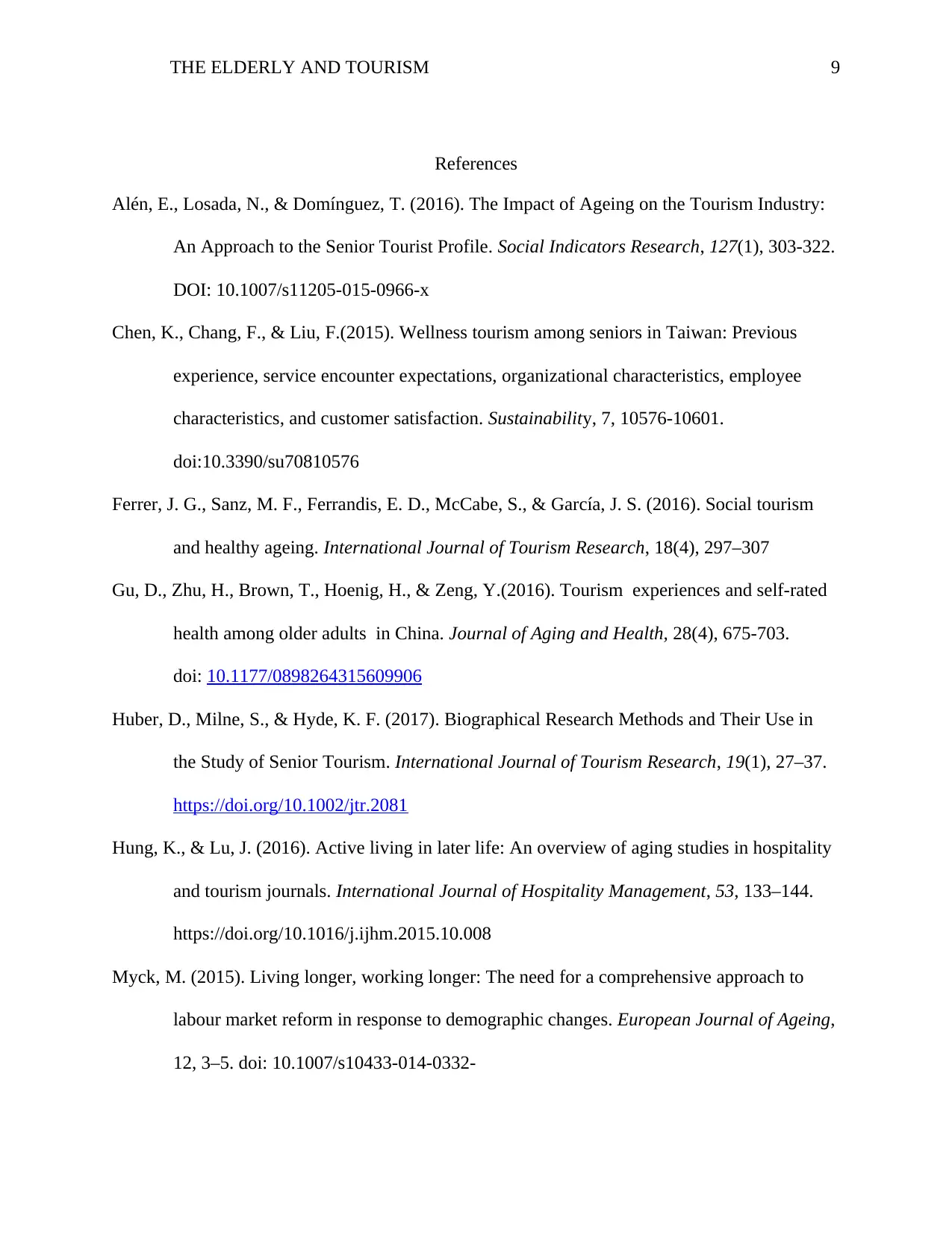
THE ELDERLY AND TOURISM 9
References
Alén, E., Losada, N., & Domínguez, T. (2016). The Impact of Ageing on the Tourism Industry:
An Approach to the Senior Tourist Profile. Social Indicators Research, 127(1), 303-322.
DOI: 10.1007/s11205-015-0966-x
Chen, K., Chang, F., & Liu, F.(2015). Wellness tourism among seniors in Taiwan: Previous
experience, service encounter expectations, organizational characteristics, employee
characteristics, and customer satisfaction. Sustainability, 7, 10576-10601.
doi:10.3390/su70810576
Ferrer, J. G., Sanz, M. F., Ferrandis, E. D., McCabe, S., & García, J. S. (2016). Social tourism
and healthy ageing. International Journal of Tourism Research, 18(4), 297–307
Gu, D., Zhu, H., Brown, T., Hoenig, H., & Zeng, Y.(2016). Tourism experiences and self-rated
health among older adults in China. Journal of Aging and Health, 28(4), 675-703.
doi: 10.1177/0898264315609906
Huber, D., Milne, S., & Hyde, K. F. (2017). Biographical Research Methods and Their Use in
the Study of Senior Tourism. International Journal of Tourism Research, 19(1), 27–37.
https://doi.org/10.1002/jtr.2081
Hung, K., & Lu, J. (2016). Active living in later life: An overview of aging studies in hospitality
and tourism journals. International Journal of Hospitality Management, 53, 133–144.
https://doi.org/10.1016/j.ijhm.2015.10.008
Myck, M. (2015). Living longer, working longer: The need for a comprehensive approach to
labour market reform in response to demographic changes. European Journal of Ageing,
12, 3–5. doi: 10.1007/s10433-014-0332-
References
Alén, E., Losada, N., & Domínguez, T. (2016). The Impact of Ageing on the Tourism Industry:
An Approach to the Senior Tourist Profile. Social Indicators Research, 127(1), 303-322.
DOI: 10.1007/s11205-015-0966-x
Chen, K., Chang, F., & Liu, F.(2015). Wellness tourism among seniors in Taiwan: Previous
experience, service encounter expectations, organizational characteristics, employee
characteristics, and customer satisfaction. Sustainability, 7, 10576-10601.
doi:10.3390/su70810576
Ferrer, J. G., Sanz, M. F., Ferrandis, E. D., McCabe, S., & García, J. S. (2016). Social tourism
and healthy ageing. International Journal of Tourism Research, 18(4), 297–307
Gu, D., Zhu, H., Brown, T., Hoenig, H., & Zeng, Y.(2016). Tourism experiences and self-rated
health among older adults in China. Journal of Aging and Health, 28(4), 675-703.
doi: 10.1177/0898264315609906
Huber, D., Milne, S., & Hyde, K. F. (2017). Biographical Research Methods and Their Use in
the Study of Senior Tourism. International Journal of Tourism Research, 19(1), 27–37.
https://doi.org/10.1002/jtr.2081
Hung, K., & Lu, J. (2016). Active living in later life: An overview of aging studies in hospitality
and tourism journals. International Journal of Hospitality Management, 53, 133–144.
https://doi.org/10.1016/j.ijhm.2015.10.008
Myck, M. (2015). Living longer, working longer: The need for a comprehensive approach to
labour market reform in response to demographic changes. European Journal of Ageing,
12, 3–5. doi: 10.1007/s10433-014-0332-
⊘ This is a preview!⊘
Do you want full access?
Subscribe today to unlock all pages.

Trusted by 1+ million students worldwide
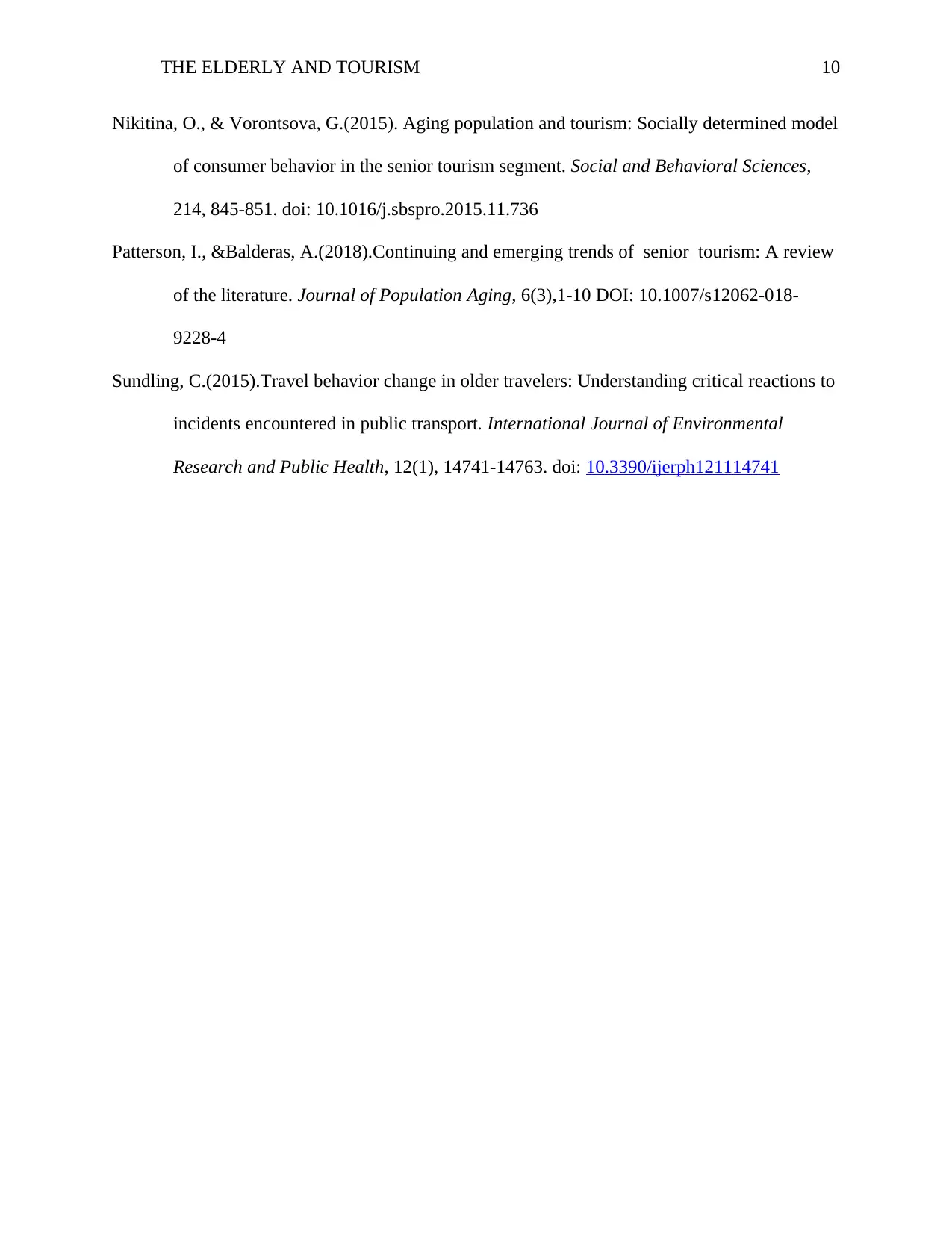
THE ELDERLY AND TOURISM 10
Nikitina, O., & Vorontsova, G.(2015). Aging population and tourism: Socially determined model
of consumer behavior in the senior tourism segment. Social and Behavioral Sciences,
214, 845-851. doi: 10.1016/j.sbspro.2015.11.736
Patterson, I., &Balderas, A.(2018).Continuing and emerging trends of senior tourism: A review
of the literature. Journal of Population Aging, 6(3),1-10 DOI: 10.1007/s12062-018-
9228-4
Sundling, C.(2015).Travel behavior change in older travelers: Understanding critical reactions to
incidents encountered in public transport. International Journal of Environmental
Research and Public Health, 12(1), 14741-14763. doi: 10.3390/ijerph121114741
Nikitina, O., & Vorontsova, G.(2015). Aging population and tourism: Socially determined model
of consumer behavior in the senior tourism segment. Social and Behavioral Sciences,
214, 845-851. doi: 10.1016/j.sbspro.2015.11.736
Patterson, I., &Balderas, A.(2018).Continuing and emerging trends of senior tourism: A review
of the literature. Journal of Population Aging, 6(3),1-10 DOI: 10.1007/s12062-018-
9228-4
Sundling, C.(2015).Travel behavior change in older travelers: Understanding critical reactions to
incidents encountered in public transport. International Journal of Environmental
Research and Public Health, 12(1), 14741-14763. doi: 10.3390/ijerph121114741
1 out of 10
Your All-in-One AI-Powered Toolkit for Academic Success.
+13062052269
info@desklib.com
Available 24*7 on WhatsApp / Email
![[object Object]](/_next/static/media/star-bottom.7253800d.svg)
Unlock your academic potential
Copyright © 2020–2025 A2Z Services. All Rights Reserved. Developed and managed by ZUCOL.